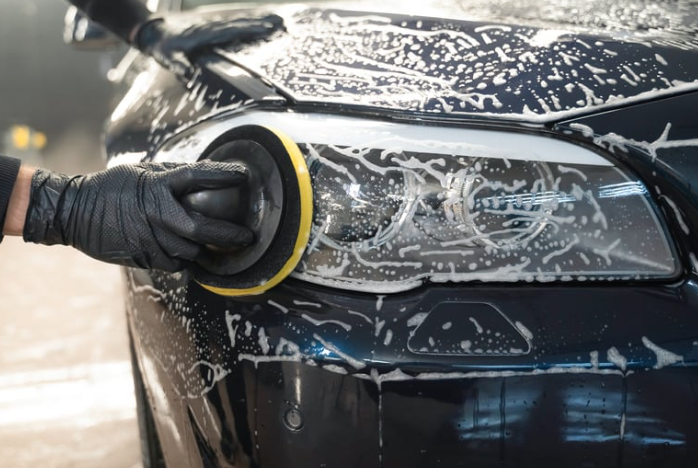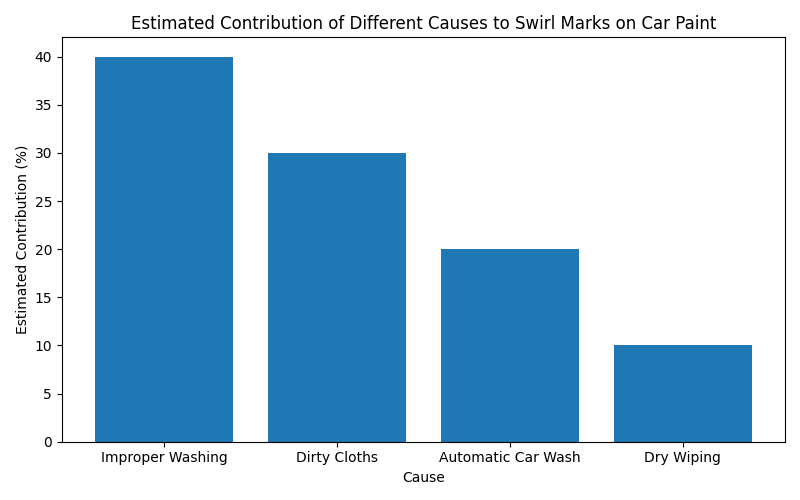How to Remove Swirl Marks and Light Scratches
Swirl marks appear as spider‑web patterns in the clear coat. They are fine scratches caused by wiping a dusty car with a dry towel or using rough or dirty cloths. Light scratches are deeper marks that may still be confined to the clear coat. They typically occur from contact with bushes, parking lot scuffs or careless washing. Unlike chips or gouges that penetrate down to the metal, swirl marks and light scratches often sit within the uppermost paint layers and can be removed or reduced through proper detailing techniques.
Step‑by‑Step: Remove Swirl Marks and Light Scratches
Removing swirl marks and light scratches involves cleaning, polishing and protecting the paint. Follow these steps for a professional result:
1. Wash the car thoroughly
Avoid creating swirls while washing. Consumer Reports advises against moving the sponge in circles because that can produce “light but noticeable scratches called swirl marks.” Instead, they recommend moving the sponge lengthwise and rinsing the sponge thoroughly if it falls on the ground.They also stress rinsing off loose dirt before washing and working one section at a time to prevent scratches (consumerreports.org).
Use proper soaps and avoid automatic washes. Popular Mechanics notes that automated car‑wash brushes often leave tiny swirl marks in your clear coat; washing your car yourself with the right soap and tools avoids this. (popularmechanics.com). Consumer Reports echoes that using clean cloths (or hiring a hand‑wash service that does) prevents new scratches
2. Assess the scratches
Check the depth before polishing. MotorTrend explains that automotive paint has three layers (primer, base coat and clear coat) and that most “trail rash” or light scratches reside in the clear coat. They suggest the fingernail test: if your fingernail catches on a scratch, it’s too deep for DIY methods and likely needs professional repair (motortrend.com).
3. Apply a swirl remover or polishing compound
Use the right products and technique. MotorTrend states that minor scratch removal usually involves either a three‑step process (compound, polish, then wax) or a one‑step product; each step progressively improves the finish. They add that using a dual‑action (DA) polisher provides better, safer coverage than polishing by hand and is the tool most detailers use (motortrend.com).
Prepare the surface and apply in small amounts. Before polishing, MotorTrend’s technicians wiped the vehicle with a quick detailer and microfiber cloth to remove any lingering dust. When applying the product, they used a small amount on the pad, worked it evenly over the paint with a DA polisher, and wiped the residue away with clean microfiber towels. Multiple passes may be needed for deeper marks.
4. Use a clay bar if needed
Remove bonded contaminants before polishing. Road & Track’s guide to clay‑barring explains that this “humble yet mighty clay bar” step is crucial for serious enthusiasts; it removes contaminants from the paint before waxing, which “reduces scratches, swirls, and grit”roadandtrack.com. Including this step helps ensure the polish works evenly and prevents dragging contaminants across the paint.
5. Wipe clean, inspect and repeat
Follow manufacturer procedures and avoid rotary buffers. A Nissan technical service bulletin hosted by the National Highway Traffic Safety Administration (NHTSA) instructs technicians to rinse the vehicle thoroughly, ensure surfaces are dry and cool, and use a dual‑action random‑orbital polisher with a soft foam pad – not a rotary buffer – because rotary buffers can create new swirl marks. The bulletin recommends keeping the pad flat, moving slowly with light downforce, maintaining a wet surface and wiping away polish residue with a clean, seamless microfiber towel. It notes that microfiber towel seams can scratch paint and advises repeating the polishing steps until swirls are removed, verifying the result with a 50/50 water and alcohol wipe.
6. Apply a protective wax or sealant
Finish with wax to protect your work. MotorTrend’s demonstration concludes by using a one‑step polishing wax, which combines polishing and waxing in one application They emphasize covering all painted surfaces and wiping off the wax with microfiber towels (motortrend.com). Waxing seals the corrected finish and guards against UV rays, dirt and new scratches, preserving your efforts.
Preventing Swirl Marks and Scratches
Keeping your paint pristine requires adopting good habits:
Wash and dry properly. Regularly washing your car with clean water, a pH‑balanced soap and soft microfiber tools removes abrasive dirt before it can scratch the paint. Never wipe a dry, dusty surface – rubbing a cloth on a dry car is a common cause of swirl marks (knowhow.napaonline.com).
Use two buckets. One bucket should hold clean, soapy water and the other rinse water. This method minimizes the chance of reintroducing grit onto the paint surface.
Avoid automatic car washes with stiff brushes. These brushes can leave fine scratches and swirls. Touchless or hand washes are safer options.
Store clean towels. Always use fresh, soft towels for washing, drying and polishing. Dirty or rough cloths can scratch the clear coat.
Data Insight: Causes of Swirl Marks
Swirl marks rarely happen on their own; they stem from daily habits. The bar chart below illustrates estimated contributions of different causes to swirl mark formation. Improper washing techniques and using dirty cloths are by far the biggest contributors. Dry wiping and automatic car washes also play roles, though to a lesser extent.
Common Mistakes to Avoid
Removing swirl marks and light scratches is a delicate process. Avoid these pitfalls:
Skipping the wash step. Applying polish on a dirty surface pushes grit into the clear coat and creates new scratches.
Using too much pressure. Whether polishing by hand or with a machine, use light, even pressure. Heavy force can burn through the clear coat or create uneven gloss.
Choosing the wrong compound. Aggressive compounds cut quickly but can leave hazing or micro‑marring. Start with a mild polish and step up only if necessary.
Neglecting protection. Omitting wax or sealant after polishing leaves the paint unprotected and prone to new swirl marks.
How Prestige Bodyworks Handles Paint Correction
After you understand the basics, you may realize that professional results require professional tools. Prestige Bodyworks in Oxnard performs paint correction and scratch repair using manufacturer‑approved products and techniques. Our technicians inspect your vehicle to determine whether imperfections are confined to the clear coat or penetrate the base coat. For surface defects, they use calibrated dual‑action polishers, ultra‑fine polishes and OEM‑specific buffing pads to remove swirl marks without damaging the surrounding paint. Deeper scratches are repaired by blending and repainting panels, ensuring a perfect color match. After correction, the team applies a premium ceramic coating or wax to protect your investment for months.
What to Expect When Seeking Professional Help
Removing swirl marks professionally often takes one to three hours, depending on the size of the vehicle and severity of the damage. Light scratch repair that requires blending or repainting may take longer. Costs can vary widely, but expect to pay a few hundred dollars for a full paint correction session; deeper scratch repair costs more because of the labor and materials involved. A detailed inspection helps determine whether a polish alone will suffice or if repainting is required.
Conclusion
Swirl marks and light scratches detract from your car’s appearance but are often reversible. By washing properly, using swirl removers, and protecting the paint with wax or sealant, you can restore your car’s shine. Taking preventive measures – like avoiding dry wiping and using clean microfiber cloths – will keep your finish looking its best. For busy drivers or those dealing with deeper scratches, the certified technicians at Prestige Bodyworks are ready to help. With professional equipment and expertise, they can remove imperfections and safeguard your vehicle’s long‑term value.






